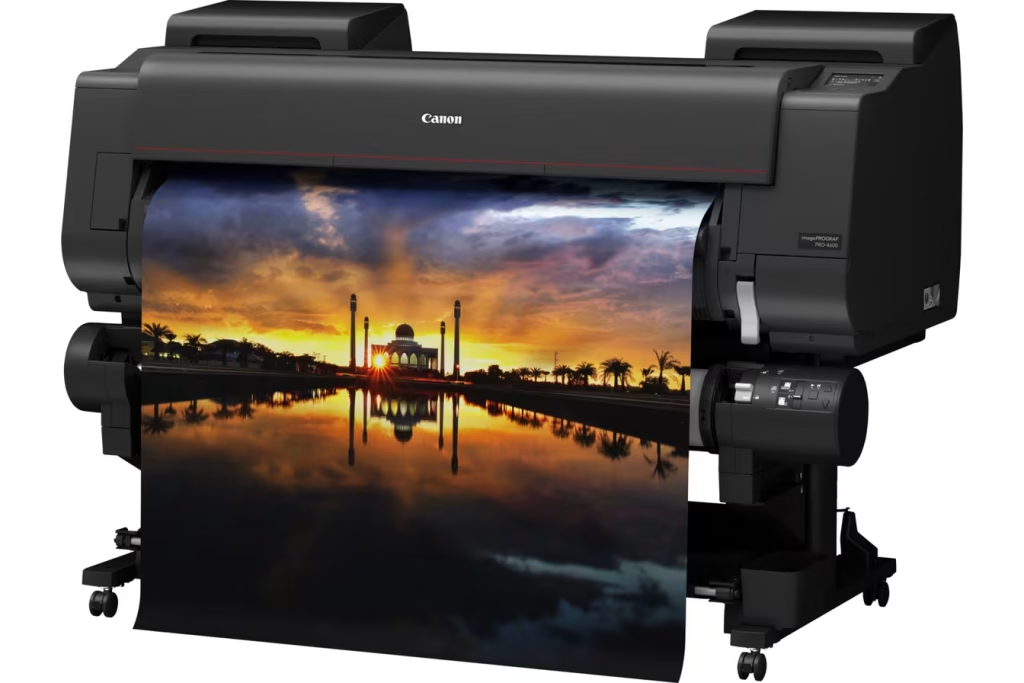FILES
- When saving your file, avoid using compression algorithms suggested by software such as Adobe Photoshop or others. In the case of TIFF files – whose most well-known algorithm is Lempel-Ziv-Welch (LZW), available since 1988 – choose either this algorithm or “No Compression” / “Uncompressed”.
- If you choose to send a JPEG, make sure to save it at the highest quality. However, we recommend avoiding JPEG whenever possible. It’s great for many things – but not for printing.
- Do not send layered files, especially if they contain unrasterised fonts, paths, or similar elements.
- Flatten your image to a single layer before sending your files.

COLOUR MODE
Don’t worry – we’re well aware of the whole mythical CMYK debate, prepress workflows, subtractive vs additive colour modes, and all the stories that come with it. But there are a few things you should know before swearing by the classic “CMYK is the only way”.
The way colours are produced in some modern printers — including the Canon imagePROGRAF PRO 4600, 4100 and 2100 models we use at Pigmento — allows them to reproduce colour “natively”, i.e., not merely as the result of a subtractive process combining Cyan, Magenta, Yellow and Black (Key). By being able to apply colours directly, or by accessing a much wider range of combinations, the result is, inevitably, stunning prints.
Even in a more “traditional” printing service, you can — and should — use CMYK for works being sent to print in two specific cases, namely:
- You are absolutely sure which ICM profile the printer is calibrated to;
- You’re using certain spot colours, where halftoning and registration issues are far more critical than colour accuracy — which, admittedly, is exceptionally rare.
In all other cases, there is a considerable risk that your CMYK files will be converted to RGB (or more accurately, to CIELab), and then back to CMYK, in order to match the ICM profile used in the workflow.
Modern printing workflows (RIP) are far more competent at handling RGB conversion. >> …CMYK than a conversion done manually in your preferred software. Take note: never work in or convert to CMYK unless you have full control over the entire (calibrated) workflow — and that includes the printers themselves.
With us, the best colour profile to use is ProPhoto and Adobe RGB — or alternatively, the smaller-gamut sRGB IEC61966-2.1. At Pigmento, we use 12-colour machines and have a rich ink range at our disposal, so there’s no reason to limit your files unnecessarily.
BLACK & WHITE (P&B)
Thanks to the type of printers we use — with 12-colour capacity, including two shades of grey and two blacks — we’re able to produce true black-and-white prints, without the need to add colours to balance the greys. When placing your order, you may (as an extra precaution) indicate that the files are black and white.
RESOLUTION
The “ideal” resolution is 300dpi at the desired print size. If your file doesn’t meet this resolution, feel free to contact us — we’ll do our best to resize (upscale by interpolation) your work with minimal quality loss.
Our printers do not apply sharpening or any kind of enhancement of that nature, but we generally assess the need for added sharpness during the pre-press stage. If necessary, we’ll apply sharpening to your image — and we’ll contact you if that’s the case.
MAXIMUM PRINT DIMENSIONS
At the moment, we print giclée up to 44″ / approximately 110 cm in width (the narrowest side), and up to 18 metres in length (roll format). We do love printing in A0, but the truth is — we’ll print with the same care and joy from A5 all the way up to the maximum size our equipment allows.

IMPORTANT NOTE: We highly recommend including a white border (or margin) with all prints. This margin serves several important purposes:
- makes handling the printed work easier;
- simplifies framing;
- acts as a sacrificial area in case of any damage to the edges of the paper.
However, we also offer the option of borderless printing.
Before we begin any order or production, our team will contact you to confirm the file(s) compliance, intended sizes, margins, shipping details, and any other relevant information.
If you have any questions or need assistance, don’t hesitate to contact us at info(at)pigmentocoolectivo.com. You can rest assured — everything is thoroughly reviewed and confirmed before production begins.
Your peace of mind is very important to us.
In short, aim for the following when preparing your files…
- TIFF, PNG, PDF or JPEG (JPG)
- Flatten your files
- Prophoto, Adobe RGB, sRGB (or CMYK)
- 16-bit (or 8-bit)
- Resolution between 180 and 300 ppi

